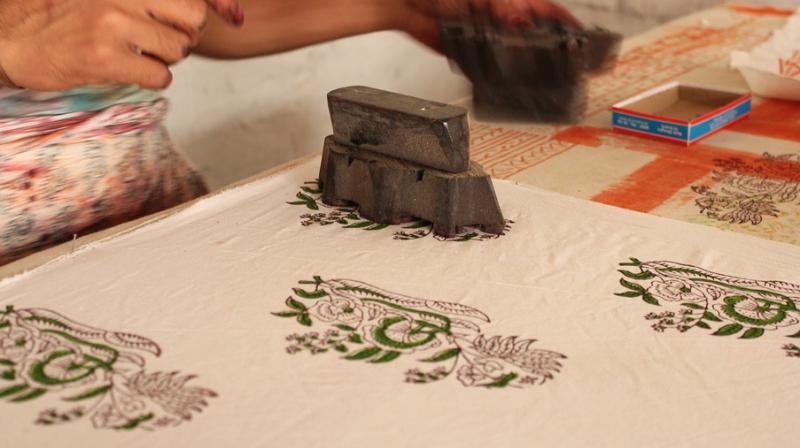New methods threaten ancient craft of organic Kalamkari
The process of involves several steps, one of which is to wash the fabric in the Krishna River to ensure that the colour lasts longer.

A tiny town known for the exquisite Kalamkari style of textile printing - which earned it a GI tag - may be losing its sheen, thanks to a spurt in the use of modern and chemical methods that threaten the traditional art of block printing on fabric using organic and vegetable dyes.
Driving through the town, it is not uncommon to see yards of kalamkari fabric laid out to dry in the scorching sun, with the ambient sounds of nature seemingly bringing alive the trees, birds and animals on the textile.
In 2013, Pedana town and its neighbouring villages of Machilipatnam, Polavaram and Kappaladoddi in the Krishna district of Andhra Pradesh won the geographical indication (GI) tag for the production of Machilipatnam Kalamkari, which involves carving out intricate designs on wooden blocks, and using these to print patterns on fabric.
However, to keep up with growing demands and reduce production costs and time, many villagers have started using chemical dyes and the screen printing method to produce the famed textile style. The modern technique involves digitally creating designs and then making large stencils, which are used instead of blocks.
The name kalamkari is derived from the words qalam (pen) and kari (craftmanship), meaning drawing with a pen. While the Srikalahasti style of kalamkari describes a freehand drawing with a pen, Machilipatnam Kalamkari uses wooden stamps to create patterns on fabric. "What the screen printing method can produce in 40 minutes, block printing or hand painting can take days," said Varun Kumar Pitchuka, who along with his father Pitchuka Srinivas is trying to continue with their family business of producing authentic kalamkari products.
The process of kalamkari involves several steps, one of which is to wash the fabric in the Krishna River to ensure that the colour lasts longer. According to Varun, the water in the river has the correct mineral composition required to help the colours develop and set.
However, the chemical dyes used by other producers have begun to pollute the river, and local farmers are beginning to feel the difference in the water. "They (the farmers) think our products are spoiling the water. When we tried to take action to stop the use of chemical dyes, local politicians stepped in to safeguard the interests of the other producers. Now the whole kalamkari community is against us," said Srinivas.
The duo has set up a small kalamkari museum showcasing the original tools used in the craft and their family's history and contribution to kalamkari. P Veera Subbaiah, Srinivas' father was the first to introduce the art of kalamkari to Pedana. "In one day, my workers are paid Rs 300 and can produce only two pieces - no matter how hard they work. But we are not harming the environment in the process," Srinivas said.
In 2003, a US-based designer visited Srinivas and, impressed by the organic method he uses, started commissioning her own designs to the father and son. Her company Les Indiennes' markets organic kalamkari fabrics for home upholstery. "Indians don't seem to value their own art form. Most of our market is outside India," Srinivas said.
The cheaper, inorganic kalamkari, which is half the price of organic fabrics, has taken over markets across India, making it difficult for the old-time producers to compete with the new. Most producers have long shifted to screen printing and chemical dyes to be able to stay in business.
"If this continues, soon the future generations will only see original kalamkari in museums," Srinivas said. "There is a lack of awareness on the issue. Most people don't understand why it is important to support the original art form," said Abhiram Natarajan, a 25-year-old B-tech graduate working with a Bangalore based not-for-profit organisation 1M1B (1 Million for 1 Billion).
The organisation works towards solving grass-root level issues of rural areas by connecting them to relevant start-ups, creating new jobs for the locals and helping budding entrepreneurs gain access to larger markets. Natarajan spent months travelling from village to village, to understand the problems of local entrepreneurs and find sustainable solutions.
After realising that Srinivas was among the few people whose practice was environmentally sustainable, Natarajan has been trying to help the father-son duo gain access to local markets. "Original Kalamkari has been an ancient industry of India that has generated employment for many people. Today this art form is at the risk of extinction," said Manav Subodh, co-founder of 1 Million for 1 Billion (1M1B).
He said only 5-10 per cent of Kalamkari coming out from Pedana and Machilipatnam was original. Recently, Natarajan helped a startup that sources fabrics for various fashion brands in India connect with the organic kalamkari businessmen. "We hope that this will help us connect people in India to original kalamkari products," Srinivas said.

